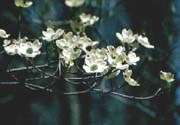
Dogwood Anthracnose is a disease caused by the fungus Discula destructiva that attacks native and ornamental flowering dogwood trees. This disease was first noticed in New York in the late 1970’s. It wasn’t detected in Maryland until 1983, but judging from the existing damage to trees and its wide distribution across the state, the disease had most likely been in the state for a few years. Dogwood trees can be affected at any time throughout the growing season, but are most susceptible to the fungus in the cool, wet seasons of spring and fall. Trees weakened by drought or winter injury are especially vulnerable to infection. Spotting on leaves and flower bracts are the first signs that a tree has been infected. These spots are tan with dark purple borders and normally appear in mid to late May. During cool, wet weather blighted gray and drooping leaves are also noticeable. The fungus then spreads into the twigs and limbs, eventually killing them. As a result of twig and limb death, the tree will produce succulent shoots on the lower trunk and main branches. These new branches are very prone to infections, which can then transport the disease into the trunk. The origin of the Dogwood Anthracnose is unknown. Possibly it may have been introduced or was an existing pathogen that altered its host due to a change in environmental conditions. The Maryland Department of Agriculture Forest Pest Management Section is conducting long-term studies on the impact of this disease on Maryland forests. At Catoctin, many native dogwood trees have succumbed to the Dogwood Anthracnose. This tremendous loss of dogwoods has altered the forest both scenically and ecologically. In 1991, it was estimated that 79% of the park’s dogwoods were dead, with no sign of regeneration. At this rate, dogwoods would soon be eliminated from the park. However, a few dogwood trees have been discovered at Catoctin that show resistance to the disease. Research conducted by The University of Tennessee Dogwood Research Group has produced an anthracnose resistant tree, the Appalachian Spring, using clones from Catoctin trees. Some of these disease resistant trees were planted in the Catoctin forest in 2001 in hope that this beautiful understory tree can be restored. American Chestnut Blight The American chestnut tree (Castanea dentata) once dominated the eastern forests from Maine to Alabama and comprised 50% of the mountain forests of this country. It is estimated that if all the chestnut trees alive at that time had been in one pure stand, there would have been a forest of nearly 9 million acres. In size they were the "redwoods of the east" growing to a height of over 100 feet and a diameter of nearly 10 feet. Renowned for their weather resistant wood (many of the cabins in the park are constructed from chestnut wood) and dependable crop of nuts, chestnut was of great value to man and wildlife. These giants are now absent from the landscape: a tragic loss which has been said to be one of the worst natural calamities ever experienced by this nation. In the early 1900's a fungus (Endothia parasitica) was accidentally introduced into New York City from trees imported from Asia. The blight quickly spread on its new host, the American chestnut, destroying it throughout its range. The disease reached the Catoctins in 1912 and by the 1940's had killed most of the large chestnut trees. Today, chestnuts can only be found in the understory, as shoots from the blight resistant roots. By the time they reach 20 feet in height the blight attacks and kills them. The American Chestnut Cooperator's Foundation (ACCF), is a grassroots organization that is working to defeat the chestnut blight. In the past they have held grafting clinics in the park in hopes of developing a blight resistant tree. The scionwood used in these grafts are selected in ACCF plantings of original sources of blight resistance and all-American intercrosses which had the best reaction to inoculation with the blight fungus. However, they are not immune to blight infection. Breeders anticipate that more generations of selections, including additional source of blight resistance, may be necessary to develop a blight resistant chestnut. West Nile Virus West Nile Virus (WNV) was first documented in North America in late summer of 1999. It is not clear where this mosquito borne virus originated, but it is most closely related genetically to strains found in the Middle East. WNV is responsible for causing West Nile Encephalitis in birds, horses, and humans. Encephalitis, or inflammation of the brain, can be deadly. The WNV is transmitted in a mosquito-bird cycle. A mosquito bites an infected bird and is now a carrier of the virus. If this infected mosquito then bites a human, horse, or bird its host will then be contaminated with the WNV. There has been no detection of WNV in Catoctin Mountain Park. In the summer of 2001, Catoctin, along with other parks in the region, began a mosquito monitoring program. Traps were set up in “swampy” areas of the park to collect mosquitoes so they could be analyzed for WNV. All mosquitoes tested negative for the virus. Monitoring will continue at Catoctin. In 2002 WNV has moved south and west, as expected would happen due to bird migratory routes. The virus has been detected in IL, MN, NE, ND, OK, SD, TX, IO, and WV. It is predicted that WNV will reach Central and South America sometime in 2002. More information regarding WNV can be found on websites of the Center for Disease Control and the United States Department of Agriculture . |
Last updated: May 2, 2020
